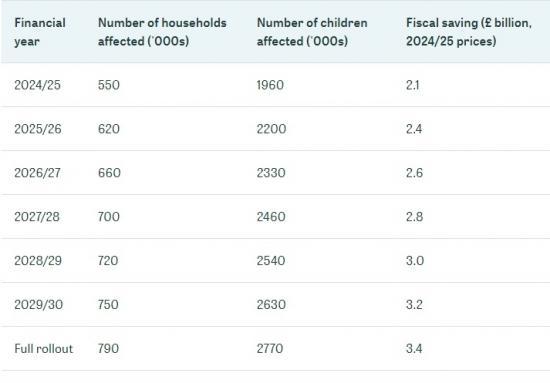Without Reform, The Two-child Limit Will Affect 670,000 Additional Children By The End Of The Next Parliament
18th June 2024

The ‘two-child limit' policy caps at two the number of children low-income families can claim additional universal credit for.
The ‘two-child limit' policy caps at two the number of children low-income families can claim additional universal credit for (worth £3,455 per year per child). Neither the Labour nor the Conservative manifesto referenced the limit, while the Liberal Democrats and the Green Party have pledged to remove it. The policy only applies to children born after 5 April 2017, so more children are affected with each year that passes. Currently, it affects around 2 million children; this will rise by 250,000 next year and by 670,000 before the end of the next parliament.
These are findings from new IFS research released today, funded by the abrdn Financial Fairness Trust, which explores the impact of the two-child limit and recent trends in child poverty:
When fully rolled out, the two-child limit will affect one in five children. It will affect 38% of children in the poorest fifth of households and 43% of children in households with at least one person of Bangladeshi or Pakistani origin.
The two-child limit represents a significant income cut for affected families. When fully rolled out, the average affected household will lose £4,300 a year (10% of their income). 57% of households currently affected by the limit have at least one person in work.
The share of children in large families who are in relative poverty has risen dramatically in the last decade. In 2014-15, 35% of children in families with three or more children were in relative poverty. By 2022-23, this had risen to 46%. The introduction of the two-child limit in 2017 is one of the key drivers of this trend; when fully rolled out, we expect it to have raised relative poverty among large families by around 500,000 children (4% of all children). Notably, over the same period, child poverty among families with one or two children fell from 26% to 22%.
Removing the two-child limit would cost £3.4 billion a year in the long run. For a sense of scale, this is equal to roughly 3% of the total working-age benefit budget, or the cost of freezing fuel duties for the next parliament.
Eduin Latimer, a Research Economist at IFS, said, "The two-child limit is one of the most significant welfare cuts since 2010 and, unlike many of those cuts, it becomes more important each year as it is rolled out to more families. It has a particularly big impact on the number of children in poverty for two reasons: it mostly affects poorer households and, by definition, its effects are entirely concentrated in families with at least three children.'
Mubin Haq, Chief Executive of abrdn Financial Fairness Trust, said, "The number of children affected by the two-child limit is set to increase by a third over the next five years. The limit has been a significant contributor to child poverty amongst large families during a period when poverty for families with one or two children fell. If the next government is serious about tackling child poverty, it will need to review the two-child limit. There is an inherent unfairness in the policy as it affects only those children born after 5 April 2017. The majority of families affected are in work or have caring responsibilities for disabled relatives or young children.'
Read a much bigger report HERE
